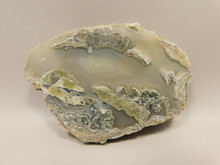Limb cast are arguably some of the most beautiful “Petrified Wood” around. But what is a limb cast?
Limb cast begin the same way that Petrified Wood does, trees are buried quickly under several hundred yards of sediment: via a volcanic eruption, or a flood or mudslide. But instead of the organic wood being sowing permineralized and slowly turning into a rock that maintains the original characteristics of the wood, in a limb cast the wood decays away leaving a cast or mold. To create the cast the surrounding sentiment must harden quickly and sufficiently to maintain the cavity in the shape of the original wood. If the sentiment is not sufficiently hard the limb cast my form slightly squashed or deformed. If the surrounding sentiment is fine-grained, the limb cast may still inherit the shape and details of the surface “bark” of the original wood.
Just as in petrified wood, the ground water will bring into the cavity minerals, most commonly silica, and these minerals over a long period time will harden to form a new rock. The final result is a beautiful chalcedony (solid colored agate) or a much rarer opal cast. Sometimes it is actually hard to identify the rock as a limb cast, because it may look just like an agate.
Some of the most beautiful limb casts are the iridescent precious opal ones found in the famous Virgin Valley site in northwestern Nevada. Other well-known limb cast areas include the red and yellow ones found in Yellow Cat , Moab and the Henry Mountains area of eastern Utah; the blue agate and green moss agate limb cast found in the south fork of the Crooked River in Oregon; the colorless to blue ones from Wiggins Fork, Worming; the very colorful ones with yellow and green in gray (with some having cavities that may have Amethyst crystals), from Tom Miner Basin, Montana; and the lovely pink ones from Texas Springs, Nevada.
Agate can form in any type of cavity, sometimes forming in small cracks and crevices of rocks or even wood. Sometimes in the forming of permineralization of petrified wood, if the wood had cracks or crevices, or some of the wood rots away before the permineralization process, agate can form in those areas and it will be clear or banded without taking on the wood’s characteristics. The agate can also have fortification. Fortification Agate is a type of agate characterized by angular, sharp, concentric bands that resemble the defensive walls of medieval fortresses. Fortification agates display crisp, geometric patterns with sharp angles and well-defined borders.
Limb cast can also contain other minerals; some are more jasper, or opaque with no particular pattern; often limb cast centers are colorless to milky crystal looking quartz; calcite, barite and gypsum can fill the center or appear as crystals in the center; and even crystals of quartz, smoky quartz and amethyst have been found in limb cast.
 US Dollar
US Dollar
 Australian Dollar
Australian Dollar
 Euro
Euro
 CAD
CAD

